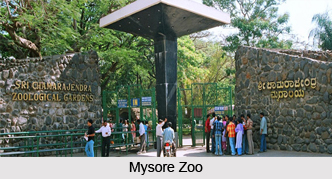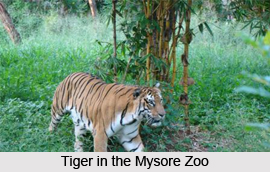 Established in 1892, Mysore Zoo is located in Mysore, Karnataka. It occupies 250 acres of land and is a well-planned zoological garden. Mysore Zoo is one of the oldest zoos in India. His Highness, the erstwhile Ruler of Mysore, Sri Chamarajendra Wadiyar Bahadur is credited with the establishment of this zoo. To commemorate the founder, the zoo is also known as Sri Chamarajendra Zoological Gardens. The Mysore zoo is graced by natural vegetation cover and rare species of plants and trees.
Established in 1892, Mysore Zoo is located in Mysore, Karnataka. It occupies 250 acres of land and is a well-planned zoological garden. Mysore Zoo is one of the oldest zoos in India. His Highness, the erstwhile Ruler of Mysore, Sri Chamarajendra Wadiyar Bahadur is credited with the establishment of this zoo. To commemorate the founder, the zoo is also known as Sri Chamarajendra Zoological Gardens. The Mysore zoo is graced by natural vegetation cover and rare species of plants and trees.
Objectives of the Mysore Zoo
Mysore Zoo is planned for recreational visits but is primarily aimed at conservation of endangered species through coordinated breeding and rehabilitation. Being an educational centre, it also aims at imparting knowledge on conservation of wildlife. Its captive breeding effort of many animals is noteworthy.
History of the Mysore Zoo
It is believed that Sri Chamarajendra Wadiyar had a vision to create a well laid-out city amidst the gardens. It was initially a private zoo and was known by various names such as Khas Bangale and Thamash Bangle. The royal family exclusively visited this zoo, but public entry started around 1920. After India attained independence, the zoo was donated by the then Maharaja to the Department of Parks and Gardens of the Mysore State Government.
Facilities for Animals in the Mysore Zoo
Mysore zoo focused on animal housing enrichments, animal comforts, hygiene and sanitation, developing better care facilities and infrastructure. Enclosures for animals in this zoo are spacious and aesthetic. Meticulous planning & scientific management is evident in the park. Double room cages with interconnected shutters are striking features of this zoo. This arrangement was made with the objective to clean the cages without putting the animals to discomfort. Thus, it was no longer required to contain the animals in the other partition of the cage by prodding and beating. Cleaning was facilitated by providing food to the animals while the cage is being cleaned. Even the workers no longer needed to work with the fear of being mauled by the animals, due to the provision of the shutters. The zoo is successful in creating natural habitat conditions for different species, which suggests that the animals feel at home in the zoo.
New enclosure for Mandrill was constructed in 1988. A large ape enclosure in this zoo was built with big trees, bushes and lush grasses for the animals to enjoy. This was the first ape enclosure in India. Nilgiri langurs were blessed with the construction of this large naturalistic ape enclosure in 2003. This was one of the greatest achievements of the zoo in that year. Presently, though the Mysore zoo is over a century old it has spacious enclosures, walk through, a veterinary hospital with facility for quarantine, an operation theater, medicine rooms and wards for animals. The Mysore Zoo also has a small museum which exhibits stuffed animals, a fish aquarium, a small library and a walk through reptile.
Animal and Bird Species Protected in the Mysore Zoo
Sri Chamarajendra Zoological Gardens shelters a variety of species not only of this country, but from about 40 different countries in the World. The Maharaja in his travel abroad collected rare animals from different countries and added them to the zoo`s collection. Animals available in the Mysore forests were exchanged for the animals procured from other countries. Therefore, acquisition of a large number of animals of different species became a reality. Mysore zoo is among the few in India housing African elephants as well as breeding them. Gorilla and Penguin arrived first in the zoo of Mysore. The zoo houses green anacondas, contributed by the Colombo Zoo. It also has white rhinoceroses, tigers, lions, baboons, giraffes and zebras.
Activities Undertaken by the Mysore Zoo Authorities
There are various kinds of programs arranged by the zoo authorities. Exhibitions are regularly arranged in the zoo, for example, insect exhibitions. Celebration of World Environment Day is also quite common. Importance is given to training sessions to ensure proper management of animals in the zoo. Summer camps lure children to the zoo for enjoyment and recreation. Also, boating as a recreational activity was initiated by the zoo after taking over the Karanji Lake in the year 1976. Painting and essay competitions are periodically conducted by the zoo authorities. It"s purpose is to create awareness among children regarding the conservation of wildlife. Mysore Zoo has initiated a unique scheme called the Adoption Programme. Under this scheme, one can adopt an animal in a way that he can take care of their feeding expenses for a certain period of time. The one who adopts will be recognized and appreciated. He will be entitled to prescribed privileges like the certificate of adoption, complimentary pass publicity in the leading newspapers.
Centenary Celebration of the Mysore Zoo
The Zoo completed 100 years in 1992. The centenary celebrations were held from 1990 to 1991. It was marked by developmental activities like renovation & modification of the entrance gate, hospital building and walk through reptiles. The establishment of the logo of the zoo, the centenary souvenir, publication of literature and leaflets, conducting various competitions, preparation of a documentary film were other activities undertaken.
Visiting Information
Early hours of the morning when the surrounding is calm and fresh, is generally considered the most suitable time to visit the zoo. It is also an appropriate time to see all the animals. Mysore Junction Train Station is the nearest railway station to the zoo. Mysore Zoo is about 3 kms from Mysore City Bus Stand and 2 kms from Mysore Palace. Mysore City Buses ply regularly to Mysore Zoo. Auto-rickshaw services also known as jataka gaadi (horse carts) from Mysore Palace to Mysore Zoo is also available to reach the zoo.
Related Articles:
Palaces in Mysore
Culture of Mysore
History of Mysore
Mysore
Kingdom Of Mysore
Indian Wildlife
Wildlife in Karnataka



















